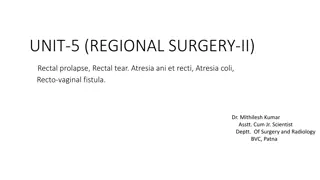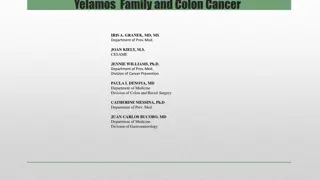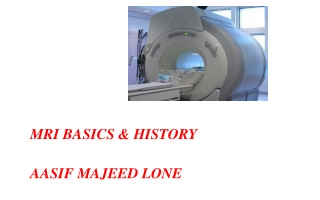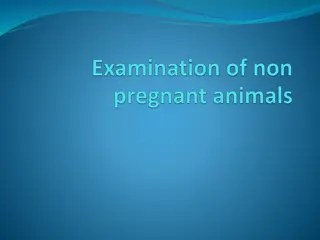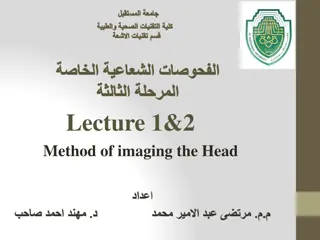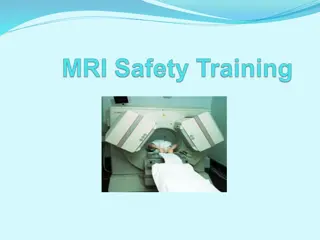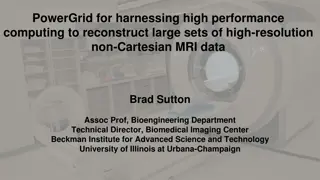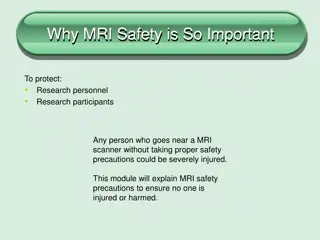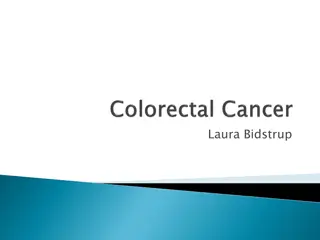MRI Assessment Findings for Colon and Rectal Cancer
Baseline MRI assessment findings for colon and rectal cancer staging include detailed descriptions of the primary tumor, its borders, extent, muscularis propria involvement, lymph nodes assessment, vascular deposits, circumferential resection margin, peritoneal deposits, pelvic sidewall lymph nodes evaluation, and suggestions for further management based on the findings.
Download Presentation

Please find below an Image/Link to download the presentation.
The content on the website is provided AS IS for your information and personal use only. It may not be sold, licensed, or shared on other websites without obtaining consent from the author. Download presentation by click this link. If you encounter any issues during the download, it is possible that the publisher has removed the file from their server.
E N D
Presentation Transcript
Reporting Proformas for Colon and Rectal Cancer The following slides are in Word format Please feel free to copy and paste into your RIS systems as proforma voice recognition shortcuts Gina.brown@rmh.nhs.uk
Clinical information: Baseline MRI Rectal Staging Assessment Findings The primary tumour is demonstrated as an [annular semi-annular ulcerating polypoidal mucinous] mass with a [nodular smooth] infiltrating border. The distal edge of the luminal tumour arises at a height of []mm from anal verge. The distal edge of the tumour lies []mm [above at below] the top of the puborectalis sling. The tumour extends craniocaudally over a distance of []mm. The tumour has a maximum thickness of []mm The proximal edge of tumour lies at a vertical distance of []mm above / below the peritoneal The invading edge of tumour extends from [] to [] o clock. Tumour is [confined to extends through] the muscularis propria. Extramural spread is []mm. MR T stage: [T1 T2 T3a T3b T3c T3d T4 visceral T4 peritoneal]. Tumour [is not] present at the distal levator level. Tumour is confined to the submucosal layer/part thickness of muscularis propria indicating that the intersphincteric plane/mesorectal plane is safe and intersphincteric APE or ultra low TME possible. Tumour extends through the full thickness of the muscularis propria : intersphincteric plane/mesorectal plane is unsafe, Extralevator APE. is indicated for radial clearance. Tumour extends into the intersphincteric plane : intersphincteric plane/mesorectal plane is unsafe, therefore an extralevator APE. is indicated for radial clearance. Tumour extends into the external sphincter : intersphincteric plane/mesorectal plane is unsafe therefore an extralevator APE. is indicated for radial clearance. Tumour extends into adjacent [prostate/vagina/bladder/sacrum] : exenterative procedure will be required. Additional comments: Lymph nodes assessment: None or only benign reactive nodes are shown [N0] [ ] mixed signal/irregular border [N1/N2] Vascular deposits : [N1c] Extramural venous invasion: [No evidence Minimal vascular spread Slight expansion of veins by tumour Clear and definite irregular expansion of vein. Small /Medium/Large vein invasion is present Venous invasion is affecting the inferior rectal / middle rectal / superior rectal / non- anatomical vein] CRM: Closest circumferential resection margin is at [] o clock. Closest CRM is from [direct spread of tumour extramural venous invasion tumour deposit]. Minimum tumour distance to mesorectal fascia: Peritoneal deposits: [No evidence Evidence]. Pelvic side wall lymph nodes: [None Benign Malignant Mixed signal/irregular border] Location: [Obturator fossa R L External Iliac Nodes R L Inf Hypogastric R L]. Opinion: [MRI Overall stage: T[] N[] M[] CRM [clear involved] EMVI [positive negative] PSW [positive negative] No adverse features eligible for primary surgery. Tumour below 6cm eligible for MERCURYEarly rectal cancer eligible for MINSTRELTumour above 15cm or Sigmoid primary eligible for IMPRESS Poor prognostic features for preoperative therapy: Eligible for SERENADE and MARVEL Poor prognostic features unsafe margins eligible for BEYOND TME trial/SERENADE/MARVEL. []mm TME plane CRM [clear involved].
Beyond TME compartment staging : to supplement main report involved CRM 1.Above the peritoneal reflection within the pelvis Disease is present/ absent Ureters are free of disease 2.Below the Peritoneum anteriorly Bladder /Uterus/Vagina/Ovaries Prostate/Seminal vesicles/Urethra are free of disease 3.Posteriorly The bony cortex/periosteum from S1-S2 is / is not involved by disease The bony cortex/periosteum from S3-S5 /coccyx is/ is not involved by disease Presacral fascia (S1/S2/S3/S4/S5) is not involved by disease Sciatic nerve/ S1/S2 nerve roots: No disease/ Disease is present 4.Laterally Pelvic fascia are free of disease Pelvic sidewall compartment are free of disease Internal/external iliac arterial /venous branches are free of disease Sacrotuberous/sacrospinous Piriformis/Obturator 5.Infralevator compartment [Tumour is confined to the submucosal layer/part thickness of muscularis propria indicating that the intersphincteric plane/mesorectal plane is safe and intersphincteric APE or ultra low TME is possible] [Tumour extends through the full thickness of the muscularis propria : intersphincteric plane/mesorectal plane is unsafe, Extralevator APE. is indicated for radial clearance] [Tumour extends into the intersphincteric plane : intersphincteric plane/mesorectal plane is unsafe, therefore an extralevator APE. is indicated for radial clearance] [Tumour extends into the external sphincter /levator /puborectalis: intersphincteric plane/mesorectal plane is unsafe: extralevator APE is needed for radial clearance.] [ Tumour extends into adjacent [prostate/vagina/bladder/sacrum] : exenterative procedure will be required 6.Anterior urogenital triangle/Perineum Vaginal introitus/urethra:free of disease Retropubic space: :free of disease Summary Total number of compartments Closest potential surgical margins are located Based on anatomic extent of disease, resection would require
Clinical information: Early rectal cancer or Significant polyp MRI assessment The primary lesion is demonstrated as a flat, polypoidal, mucin containing mass The lesion has a maximum diameter of mm and a thickness mm A fibromuscular stalk is visible/not visible, this is located at the o clock position The diameter of the fibromuscular stalk measures: The lesion is flat/semi-annular and is located in the quadrant at o clock The central depressed portion representing the invasive border of the lesion is located at o clock The depth of penetration of the invasive border into submucosa/ muscularis/ mesorectum is mm. The width of the invasive border measures mm There is full preservation of the mucosa, submucosa, muscularis propria layers at the stalk/invasive edge of the tumour mrT stage: T0/Sm1/2, T1sm2/3, T1sm3/T2 T2 T2/T3a Assessment of lymph nodes for malignant characteristics based on nodal capsule breach or heterogeneity of signal: no suspicious nodes identified, benign nodes only, N1/N2 The tumour arises at a height of mm from the anal verge and mm to the top of puborectalis sling Evaluation of extramural veins for discontinuous spread: no EMVI/ EMVI is present: Excision options for tumour free deep margins No evidence of extension into the submucosa Eligible for EMR/ ESD >1mm submucosa is preserved therefore eligible for ESD or Partial thickness TEM <1mm submucosa and >1mm of muscularis preserved : potentially eligible for TEM <1mm : preserved muscularis - TME is indicated CRM: Tumour is confined to the rectal wall therefore TME plane CRM is considered clear Closest circumferential resection margin is at [] o clock. Closest CRM is from [direct spread of tumour extramural venous invasion tumour deposit]. Minimum tumour distance to mesorectal fascia: Peritoneal deposits: [No evidence Evidence]. Pelvic side wall lymph nodes: [None Benign Malignant Mixed signal/irregular border] Location: [Obturator fossa R L External Iliac Nodes R L Inf Hypogastric R L]. ] Opinion: [MRI Overall stage: T[] N[] M[] CRM [clear involved] EMVI [positive negative] PSW [positive negative] No adverse features eligible for primary surgery: No evidence of extension into the submucosa Eligible for EMR/ ESD >1mm submucosa is preserved therefore eligible for ESD or Partial thickness TEM <1mm submucosa and >1mm of muscularis preserved : potentially eligible for TEM <1mm : preserved muscularis - TME is indicated []mm CRM [clear involved].
Clinical information: Post Treatment Assessment of Rectal Cancer Findings Comparison is made with the previous examination of []. The primary tumour and extramural disease shows: No fibrosis,TRG5 Less than <25% fibrosis, predominant tumour signal, TRG4 Fibrosis predominating but tumour signal foci still visible TRG 3 Dense fibrotic scar - minimal/no tumour signal intensity,TRG2 Low signal linear or crescentic fibrotic scar only no intermediate tumour signal TRG1 The treated tumour is demonstrated as a [crescentic scar linear scar low signal intensity annular semiannular mass] and arises at a height of []mm from the anal verge and lies at a vertical distance of []mm below the peritoneal reflection. The scar/treated tumour arises at a height of []mm from the top of the puborectalis sling. The tumour has a maximum craniocaudal length of []mm and has a maximum thickness of []mm. yMR Tumour T Stage: [T0 T1 T2 T3a T3b T3c T3d T4a]. Extramural venous invasion [EMVI TRG: fibrosis predominates in vein, tumour signal predominates in vein Small Medium Large vein invasion is present Venous invasion is affecting the inferior rectal, middle rectal, superior rectal, non-anatomical veins. Nodal Spread: N0[], N1 = 1-3 nodes[], N2 4 nodes Vascular deposits: N1c[]. Pelvic sidewall lymph nodes are present absent. Location: [Obturator fossa R L External Iliac Nodes R L Inf Hypogastric R L]. ] Fibrosis [is in submucosal layer only is confined to muscularis propria extends beyond muscularis propria extends into adjacent organ]. Extramural fibrosis measures []mm. Mesorectal fascia and surgical margins: Safe: tumour/fibrosis >1mm from mesorectal margin At risk is fibrosis 1mm or less from the mesorectal margin Involved: tumour is 1mm or less from the mesorectal margin Minimum distance to mesorectal fascia [] mm For low tumours below the level of the levators only: Safe: clear mesorectal iintersphincteric plane LS0 : Tumour /Fibrosis extends into rectal wall but there is >1mm to the intersphincteric plane: the intersphincteric plane/mesorectal plane is safe and intersphincteric APE or ultra low TME is possible LS1 : Tumour /Fibrosis extends into the rectal wall but <1mm to the intersphincteric plane: ELAPE surgery is indicated LS2 : Tumour /Fibrosis extends into the intersphincteric plane: ELAPE surgery is indicated LS3 : Tumour /Fibrosis extends into external sphincter ELAPE surgery is indicated LS4: Tumour extends into adjacent [prostate/vagina/bladder/sacrum/ pelvic sidewall]: exenterative procedure will be required.: Surgery Beyond TME plane is indicated Peritoneal deposits: [No evidence Evidence]] Opinion: [y MRI Overall stage: ymrT[] ymr N[] M[], Good prognosis, EMVI negative, CRM clear, TRG 1-2: eligible for the Deferral of surgery arm of TRIGGER trial. Intermediate/Poor prognosis, CRM pos or TRG3/4/5 or EMVI positive: eligible for Further treatment arm of TRIGGER trial. LS4: eligible for BeyondTME trial.
Colon Staging Baseline The primary tumour is demonstrated as an [annular ulcerating polypoidal villous eroding mucinous] mass and has a [nodular smooth] infiltrating border. The primary mass is located in [ caecum ascending colon transverse colon splenic flexure descending colon sigmoid]. The advancing edge tumour (border) is [mesenteric peritoneal]. Tumour [is confined to extends through] the bowel wall. Peritoneal infiltration: [no evidence evidence]. Tumour extension: [<5mm >5mm ] Extramural Tumour spread measures []mm. Tumour diameter: []mm. Tumour thickness: []mm. There is [evidence no evidence] of radiological obstruction Lymph nodes in colonic mesentery: [Benign Reactive Malignant]. Number of nodes Nodes present > 10mm Enhancing/irregular positive nodes There is [evidence no evidence] of extramural venous invasion. There is [evidence no evidence] of peritoneal dissemination. Retroperitoneal lymphadenopathy is [absent present]. Incidental note is made of [intra-abdominal pelvic] pathology. There is [evidence no evidence] of metastatic disease in liver. There [is no] segmental sparing. Incidental note is made of [cysts /haemangioma equivocal low density lesion] that [requires characterisation by MRI is recommended for follow-up is unlikely to represent metastatic disease]. Pulmonary metastatic disease: [No]CT evidence. Details: []. Opinion: Overall stage: T[] N[] M [] [resectable irresectable] EMVI [positive negative] [good/poor] prognosis Discussion points for imaging case: []. Radiologically eligible for []
10th 11thMarch 2016, London 1ST 2NDJune 2016, London Rectal MRI Intensive 2 Day Workshop HANDS ON WORKSTATION PRACTICE CASES CASE DISCUSSIONS, TRAINING FOR CLINICAL TRIALS FOR RADIOLOGISTS, SURGEONS AND ONCOLOGISTS Email: Gina.Brown@rmh.nhs.uk If you wish to receive further booking information


